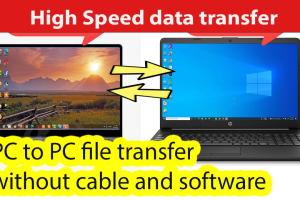Effortlessly Transfer Files: 2 Simple Methods for PC-to-PC Transfers

-
Quick Links:
- 1. Introduction
- 2. Method 1: Using a USB Flash Drive
- 3. Method 2: Utilizing Cloud Storage
- 4. Real-World Case Studies
- 5. Expert Insights
- 6. Conclusion
- 7. FAQs
1. Introduction
Transferring files between PCs can often feel like a daunting task, especially for those who aren’t tech-savvy. However, with technology evolving, there are now simpler methods that make this process not only easier but also more efficient. In this comprehensive guide, we will explore two easy methods to transfer files from PC to PC: using a USB flash drive and leveraging cloud storage solutions.
2. Method 1: Using a USB Flash Drive
2.1 What You’ll Need
- A USB flash drive with sufficient storage space.
- A computer (PC) with a USB port.
- Files you intend to transfer.
2.2 Step-by-Step Guide
- Insert the USB Flash Drive: Connect your USB drive to your first PC’s USB port.
- Copy Files: Open the folder where your files are located, select the files you wish to transfer, right-click on them, and select 'Copy'.
- Paste Files: Open 'This PC', double-click your USB drive, right-click in the folder, and select 'Paste'. Wait for the transfer to complete.
- Safely Eject: Once the file transfer is complete, right-click on the USB drive icon in 'This PC' and select 'Eject' to safely remove it.
- Transfer to the Second PC: Insert the USB drive into the second PC and repeat the copy-paste process to move files from the USB to that computer.
2.3 Advantages of Using a USB Flash Drive
- Simplicity: Easy to use for all skill levels.
- Speed: Fast transfer rates compared to online methods.
- Offline Transfer: No internet connection required.
3. Method 2: Utilizing Cloud Storage
3.1 What You’ll Need
- An account with a cloud storage provider (e.g., Google Drive, Dropbox, OneDrive).
- Internet access on both PCs.
- Files you wish to transfer.
3.2 Step-by-Step Guide
- Upload Files to Cloud: On your first PC, log in to your cloud storage account, select the files to transfer, and upload them.
- Access on Second PC: Log into the same cloud storage account on the second PC.
- Download Files: Select the uploaded files and download them onto the second PC.
3.3 Advantages of Using Cloud Storage
- Accessibility: Access files from anywhere with an internet connection.
- Backup: Files stored in the cloud are backed up and less prone to loss.
- Collaboration: Easily share files with others.
4. Real-World Case Studies
To provide context, let’s examine a couple of case studies illustrating how individuals and businesses have effectively utilized these methods for file transfers.
4.1 Case Study: Small Business File Sharing
A small graphic design firm often needs to transfer large design files between employees. By using USB drives, they were able to quickly share files without the delay of uploading and downloading, improving productivity.
4.2 Case Study: Remote Work Collaboration
A marketing team working remotely used cloud storage to share campaign materials. This method not only saved time but also allowed team members to collaborate on documents in real time.
5. Expert Insights
Experts in technology recommend a hybrid approach for transferring files. Utilizing both USB drives for large file transfers and cloud storage for ease of access and collaboration provides a well-rounded solution that can cater to various needs.
6. Conclusion
Transferring files from PC to PC doesn’t have to be complicated. By adopting either a USB flash drive or cloud storage, you can streamline the file transfer process and enhance your productivity. Choose the method that best fits your needs and enjoy seamless file sharing!
7. FAQs
1. Can I transfer files without an internet connection?
Yes, using a USB flash drive allows for offline file transfer.
2. What are the risks of using cloud storage?
Risks include potential data breaches and reliance on internet connectivity.
3. Are there size limits for file transfers using USB?
USB drives have storage limits based on their capacity, typically ranging from 4GB to 1TB.
4. Can I use my phone as a USB drive?
Yes, you can use certain apps to transfer files between your phone and PC, acting as a USB drive.
5. How secure is cloud storage?
Cloud storage is generally secure, but always use strong passwords and enable two-factor authentication.
6. What is the best cloud storage service for file transfers?
Popular options include Google Drive, Dropbox, and Microsoft OneDrive, each with its own benefits.
7. Can I transfer files between different operating systems?
Yes, most methods allow for cross-platform file transfers between Windows, macOS, and Linux.
8. How do I safely eject a USB drive?
Right-click on the USB drive icon and select 'Eject' to prevent data corruption.
9. What if the transfer fails midway?
Check the connection and try the transfer again. For cloud, ensure your internet is stable.
10. Can multiple users access files in cloud storage?
Yes, cloud storage allows for file sharing and collaboration among multiple users.
References
- Digital Trends: How to Transfer Files from PC to PC
- How-To Geek: How to Transfer Files Between Computers Over the Internet
- PCMag: How to Transfer Files to Your New PC
Random Reads
- How to post ads to craigslist
- How to create a listserv
- How to create a local area network lan
- Effective ways to remove sticker residue
- How to scan and print pictures from a computer
- How to travel from orgrimmar to silvermoon city
- How to measure voltage
- How to merge cells in excel
- How to bring back lydia in skyrim
- How to browse incognito using bing